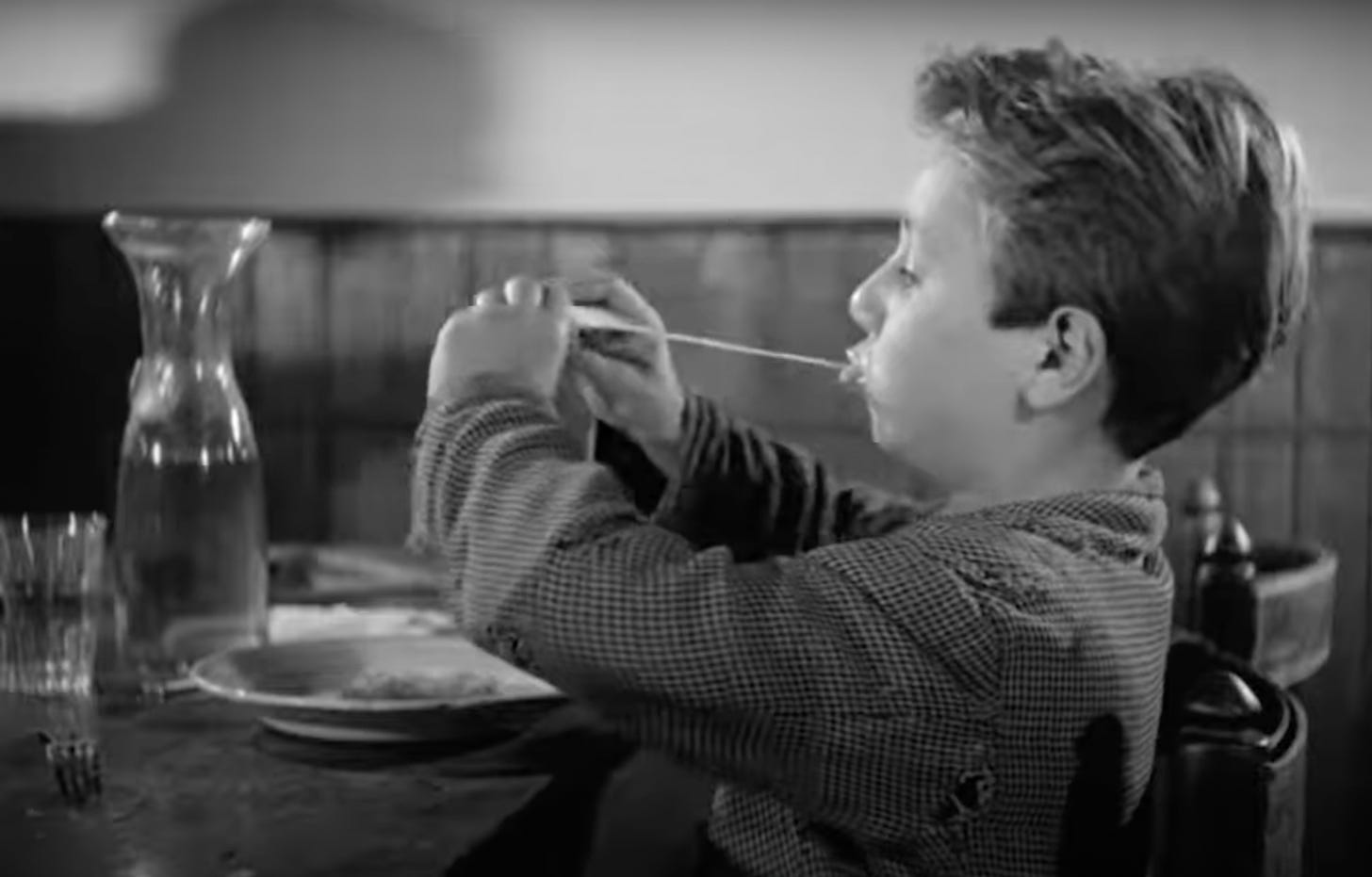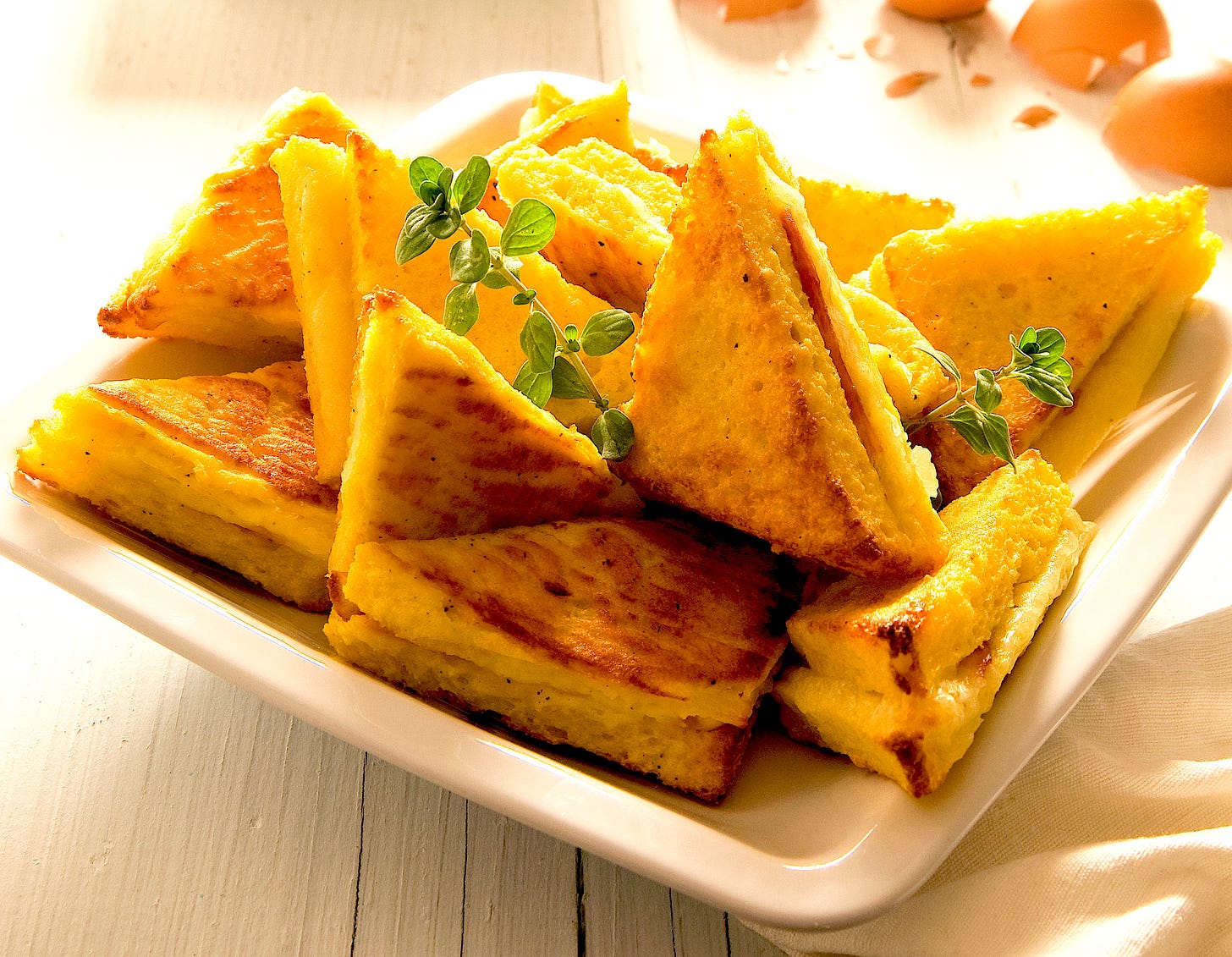Notable Sandwiches #25: The Carrozza
Reflections on Italy's decadent spin on the grilled cheese
Welcome to the latest installment of Notable Sandwiches, the feature where I, alongside my editor David Swanson, stumble through the demented and mysterious document that is Wikipedia’s List of Notable Sandwiches. This week: an Italian standard, the carrozza.
Perhaps the most famous appearance of the carrozza—short for mozzarella in carrozza, or “mozzarella in a carriage”—is in a scene from The Bicycle Thieves, the 1948 Italian neorealist masterpiece about a father and son navigating an impoverished life in Rome in the aftermath of World War II. Antonio and his plucky young son Bruno encounter all sorts of misadventures in their efforts to recover a stolen bicycle, but they stop along the way in a trattoria, where they order the humble sandwich and share a moment of rare delight, even as snootier diners around them order bevies of richer dishes. It’s a delicious moment, all the more so for the pair’s travails. “We’ll eat and be happy for now,” Antonio tells Bruno, and the child smiles, and his eyes are bright, and the cheese stretches out like reins on a carriage road, full of promise.
The carrozza is a simple dish, and, like most simple dishes, it requires some effort to perfect. The construction goes like this: take slices of mozzarella—one centimeter thick, per this Italian chef—and pat them carefully dry. Place a few of these delicate roundels between thin slices of white bread. Press until gently squished together. Cut in four: triangles or squares, as you like. Dredge the sandwichettes in flour, egg, and bread crumbs. Fry in oil until golden.
Mini fried grilled cheeses sound obscenely delicious, particularly when made with, say, fresh fior de latte mozzarella de bufala on the streets of Campania, or paired with minute slivers of anchovy and prosciutto, as they serve the sandwich in Venice. One writer for Bon Appetit, reflecting bemusedly on her childhood embarrassment about her Calabrian mother’s creations—and the delicious effrontery of being served carrozza when asking for a normal American grilled cheese sandwich—calls it a “golden, crunchy upgrade” on the American standard. Back in 2012, Village Voice writer Robert Sietsema wondered whether the carrozza might be an example of Italian-Americans influence on cuisine in the old country, given the ubiquity of the grilled cheese sandwich on these shores.
Being a staple of the home kitchen and the street cart, the carrozza is the type of humble food prone to folk origins, and orphan facts. Among assorted myths I encountered on my amble through the research: it was invented by housewives (no housewife in particular) as a thrifty and tasty way to use up bread ends and leftover mozzarella; the name comes from the fact that the sandwich used to be cut in rounds that resembled carriage wheels; the New York Times in 1971 reported derisively that a “fantasy-prone person” might see a resemblance to a railway carriage in the square-cut version; that, on the contrary, it resembled the milk wagons that schlepped dairy products from the countryside; that the mozzarella, when pulled apart between sections of the sandwich, resembles the reins on carriage horses; etc. It does seem to be a literalization of the idea that the bread should be a vehicle for the filling; and if, as the enterprising author of 1964’s Through Europe With a Jug of Wine puts it, the carrozza was “as common as ham and eggs” in Rome and Southern Italy, it makes sense that there are a surfeit of etymologies. I note that when speaking them aloud, the words themselves—mozzarella in carrozza—have a kind of clopping rhythm, rolling off the tongue like wheels along cobblestones.
The Sword and the Sandwich is a newsletter about deadly serious extremism and equally serious sandwiches. Please consider supporting this work with a paid subscription:
It’s strange to consider that cities used to be as full of horses as they are full of cars in 2022. To the rich olfactory urban bouquet in the age of the carrozza, the emanations of horses added an equine element that now seems impossibly foreign or quaint. One imagines the sheer amount of manure on city streets—along with dumped chamber pots and night-soil piles—and I for one become glad that in New York nowadays shit is mostly a stench, and the streets are more redolent of piss anyway. Today, a carriage ride is a vestigial thing, a tourist attraction or a romantic curiosity—my father proposed to my mother in a carriage in Central Park, for example.
I wonder, if we come to our senses as a species before we annihilate ourselves, what kinds of traces the car will leave on our language, and in our cuisine: echoes of the past on our plates. In the meantime, the mozzarella in carrozza seems like an excellent way to remember the centuries when horsepower meant great muscles under silky hides, and soup-plate hooves clattered over cobbles, and the milkman’s cob brought you the mozzarella you’d use to fill your carrozza. It’s easy to romanticize the past as simpler and purer, though it is just, as the saying goes, a foreign country, one with its own problems, its own webs of complexity and violence, its own armatures of prejudice and human joy. But the past stretches to the present like pulled cheese, dangling the promise of knowing ourselves by learning its secrets, and the carrozza, a simple and perfect thing, is at both ends of the arc, a promise that something, at least, has remained from the age of the carriage, hot on the tongue, a milky promising bloom.







